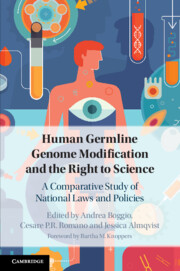 Human Germline Genome Modification and the Right to Science
Human Germline Genome Modification and the Right to Science from Part IV - Other OECD Countries
Published online by Cambridge University Press: 15 November 2019
Israel defines itself as a ‘Jewish democratic state’, an expression that conveys the Jewish and liberal roots of its political, cultural and legal identity. In Jewish tradition, attempting to cure disease and save lives is of paramount value and Jewish culture hence encourages open-minded attitudes towards research efforts that have therapeutic goals. Zionist narratives also play a role in shaping policy towards genetic and reproductive technologies and pro-science attitudes echo the Zionist narrative that links scientific and technological innovation with the notion of transforming the Jews into a modern nation. Consequently, Israel does not ban basic research involving human germline modification and draws the line only at attempting to create a ‘genetically modified person’. Human germline genome modification is regulated in Israel under the 1999 Prohibition of Genetic Intervention (Human Cloning and Genetic Manipulation of Reproductive Cells) Law. This Law has been amended three times: in 2004, 2009 and 2016. The current version is set to expire on 23 May 2020. The Israeli Law prohibits two activities: human reproductive cloning, and the use of ‘reproductive cells that have undergone a permanent intentional genetic modification (germline gene therapy) in order to cause the creation of a person’.
To save this book to your Kindle, first ensure no-reply@cambridge.org is added to your Approved Personal Document E-mail List under your Personal Document Settings on the Manage Your Content and Devices page of your Amazon account. Then enter the ‘name’ part of your Kindle email address below. Find out more about saving to your Kindle.
Note you can select to save to either the @free.kindle.com or @kindle.com variations. ‘@free.kindle.com’ emails are free but can only be saved to your device when it is connected to wi-fi. ‘@kindle.com’ emails can be delivered even when you are not connected to wi-fi, but note that service fees apply.
Find out more about the Kindle Personal Document Service.
To save content items to your account, please confirm that you agree to abide by our usage policies. If this is the first time you use this feature, you will be asked to authorise Cambridge Core to connect with your account. Find out more about saving content to Dropbox.
To save content items to your account, please confirm that you agree to abide by our usage policies. If this is the first time you use this feature, you will be asked to authorise Cambridge Core to connect with your account. Find out more about saving content to Google Drive.